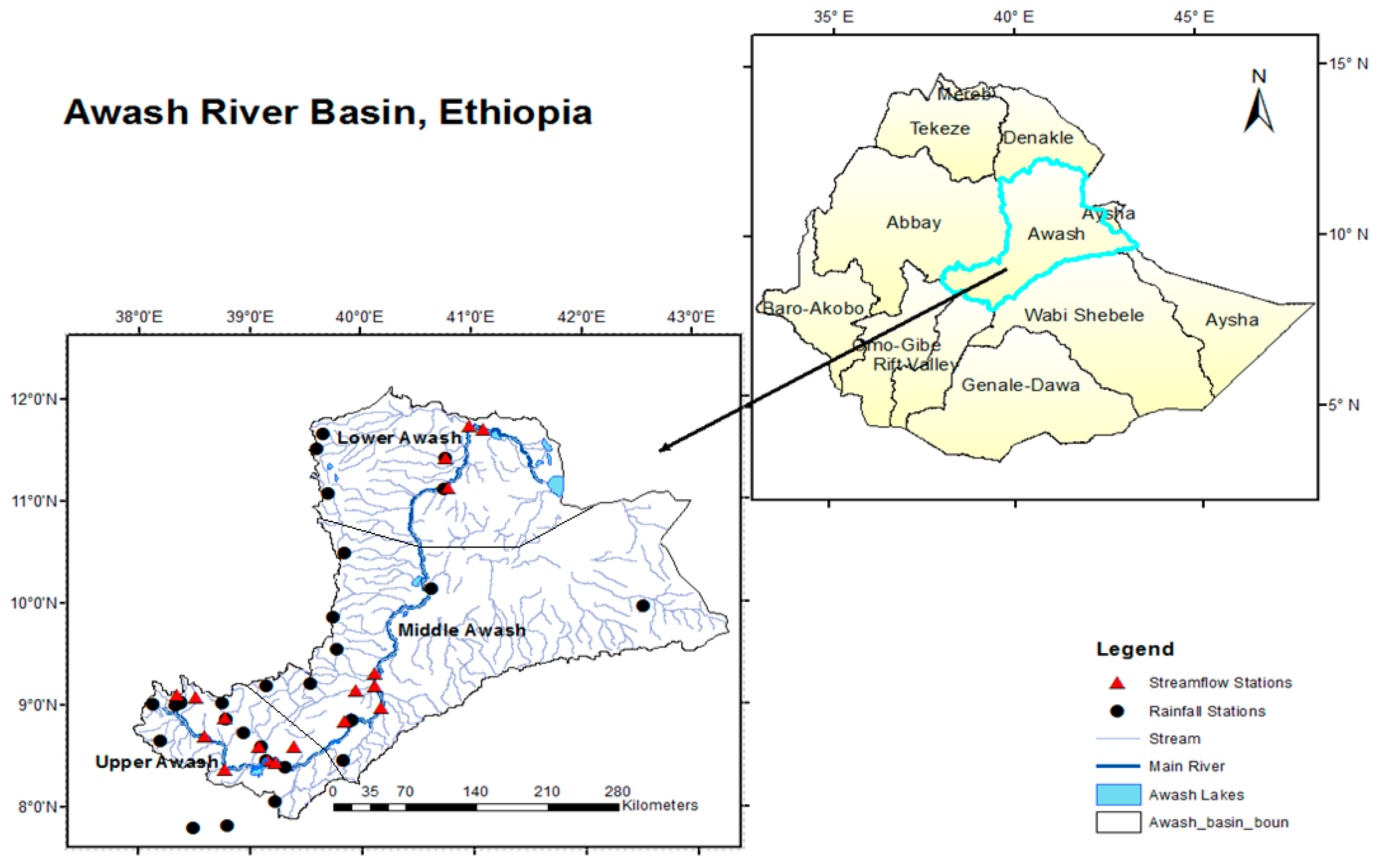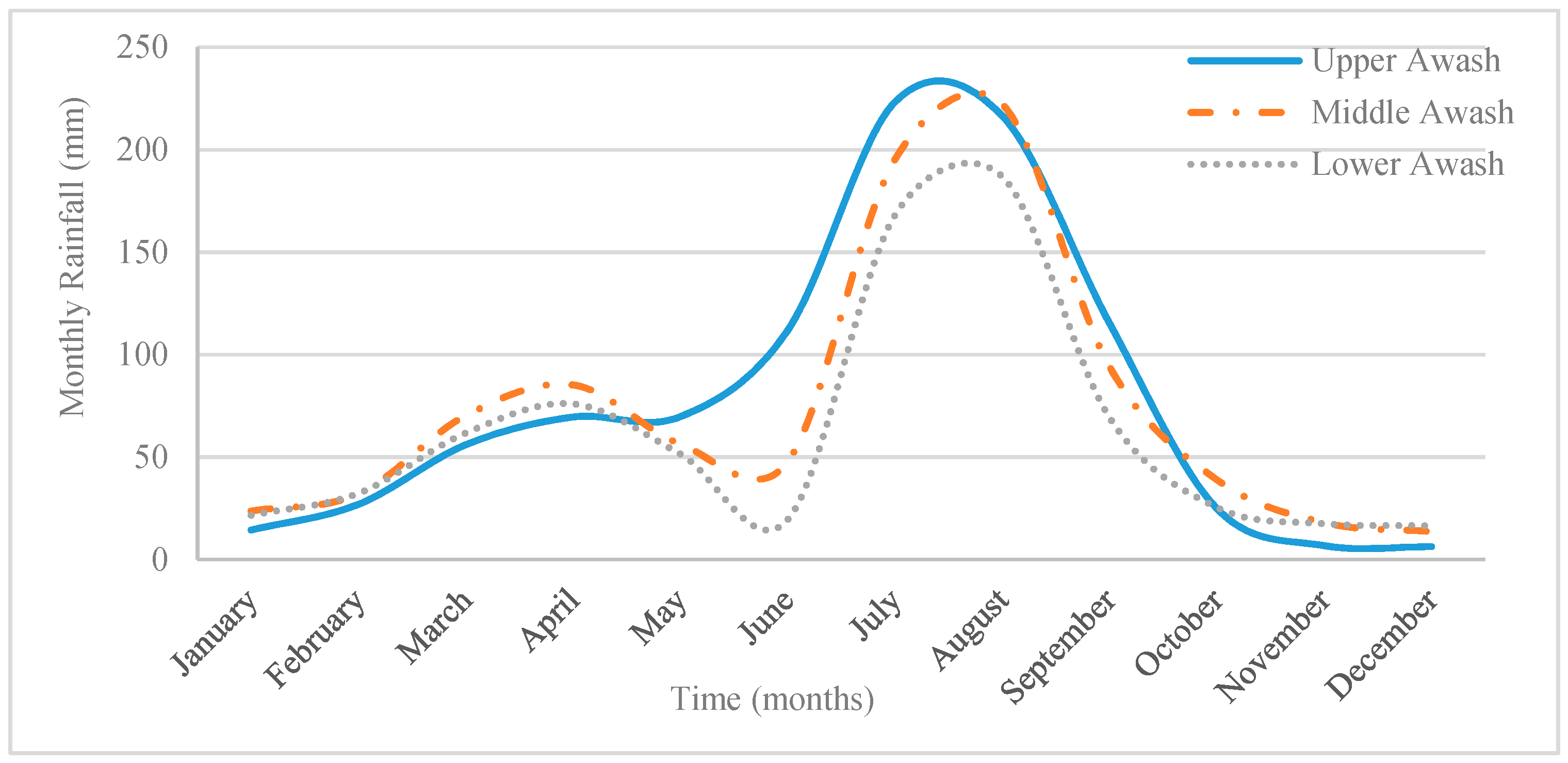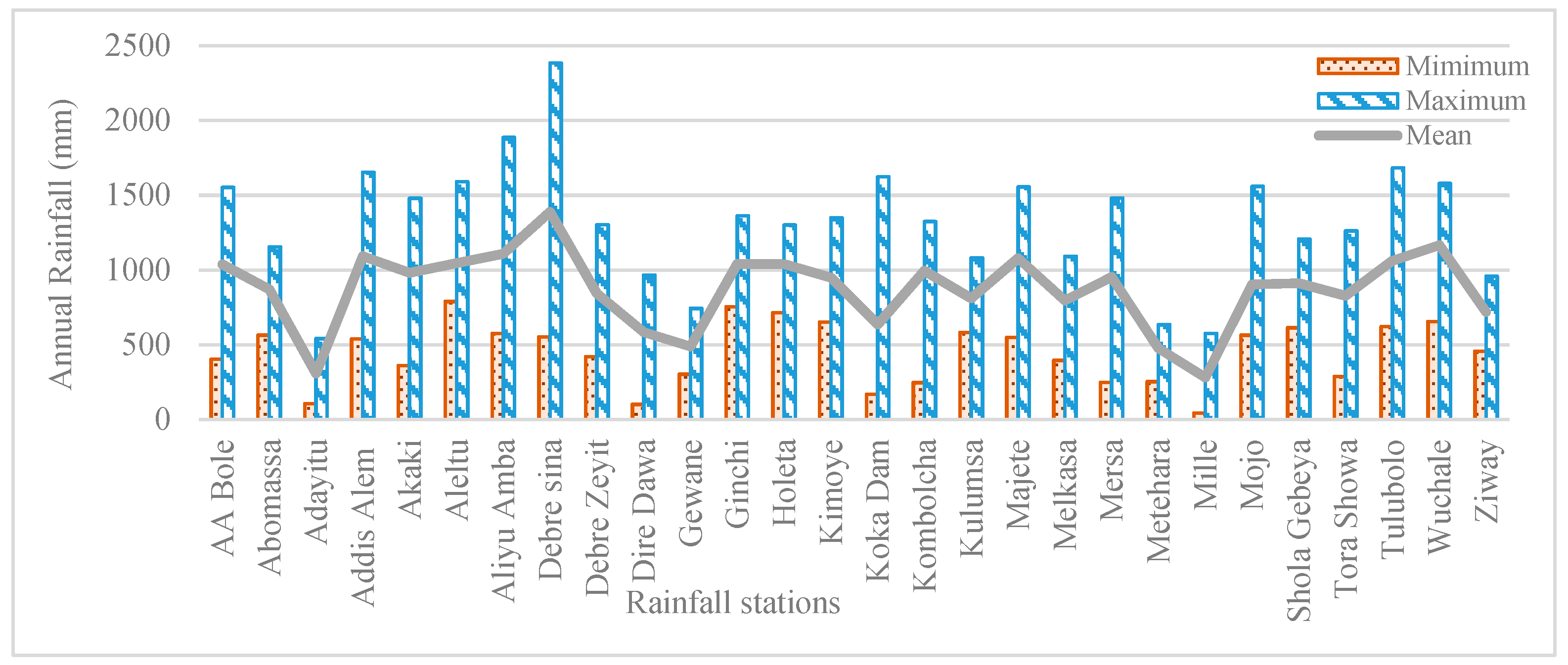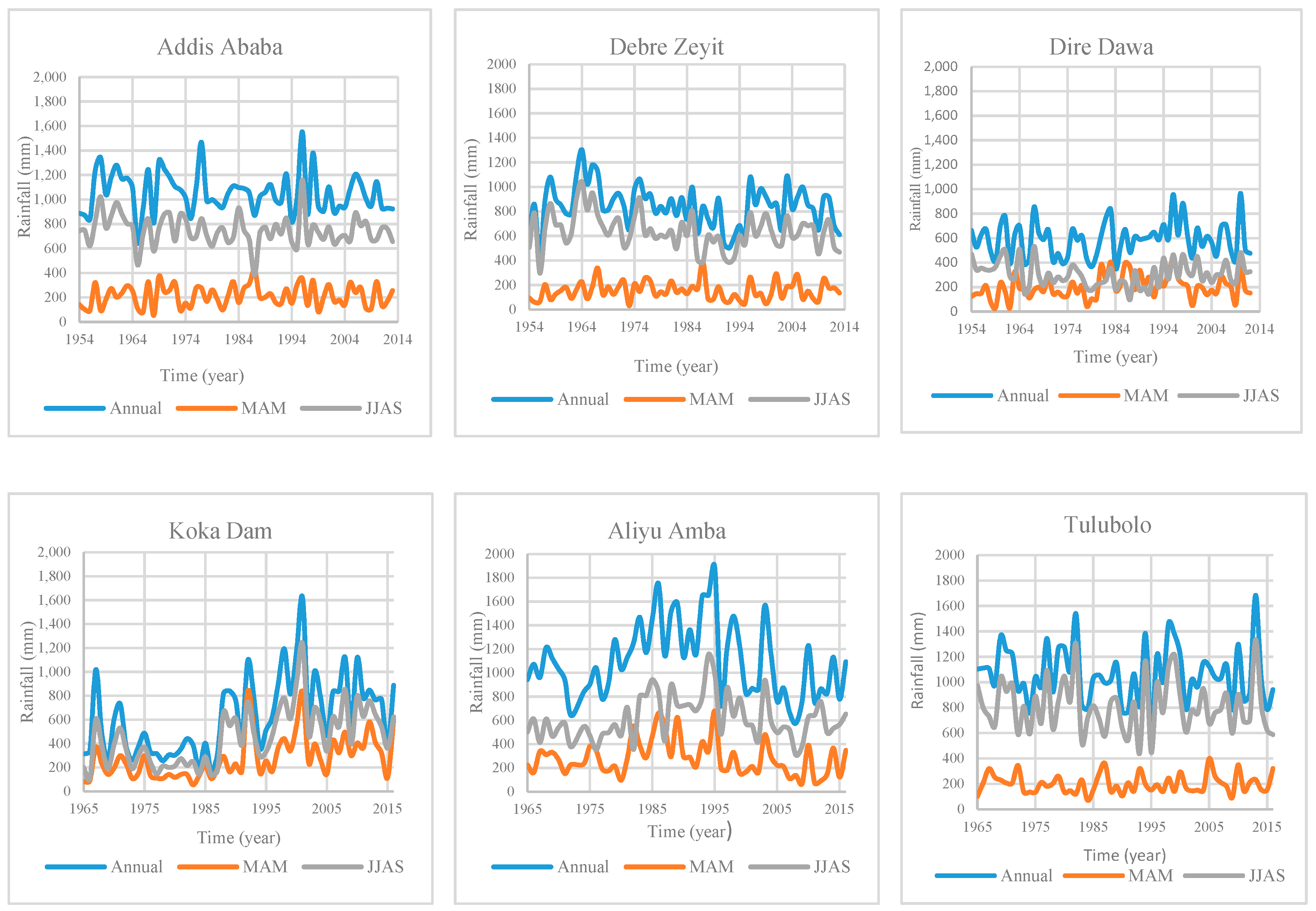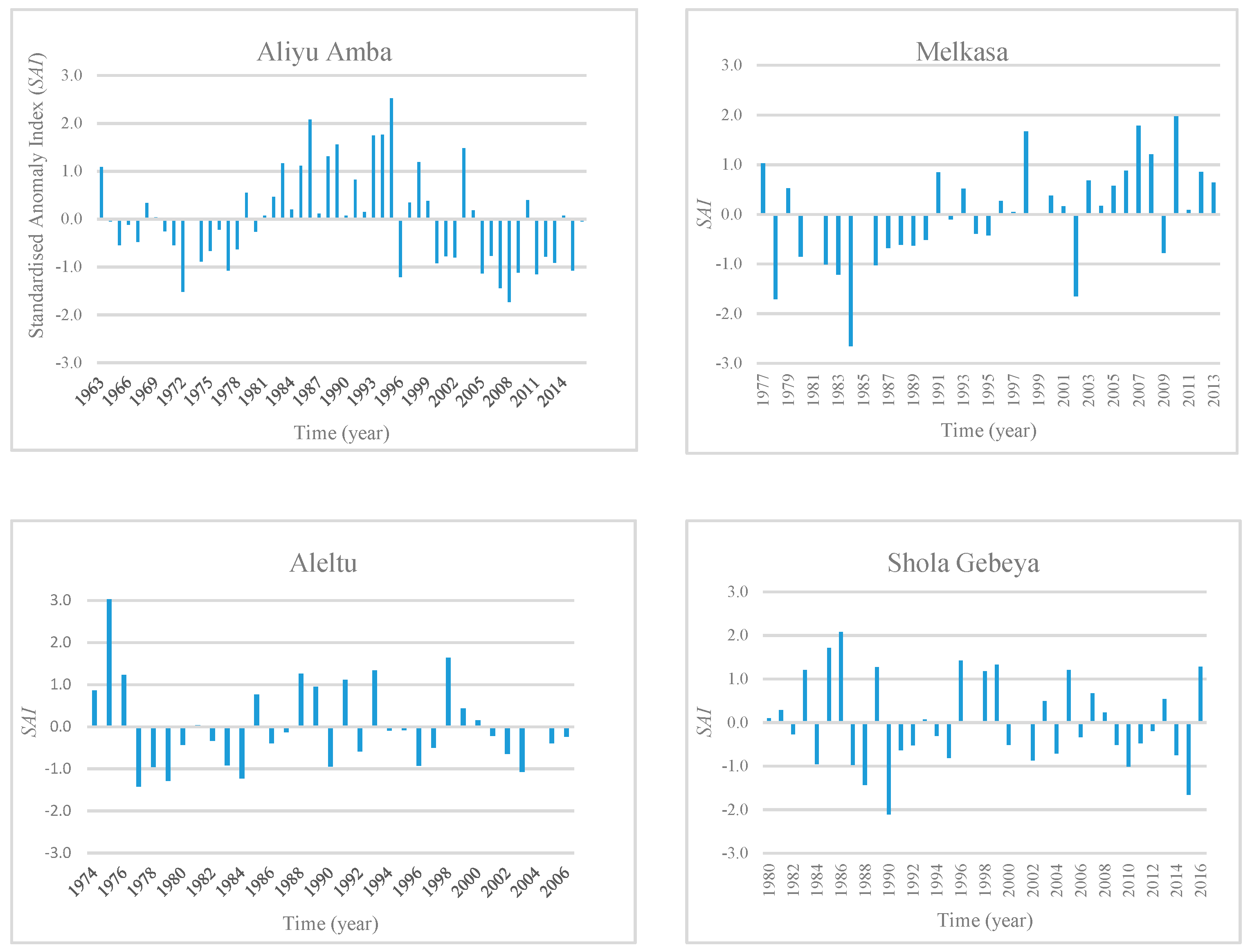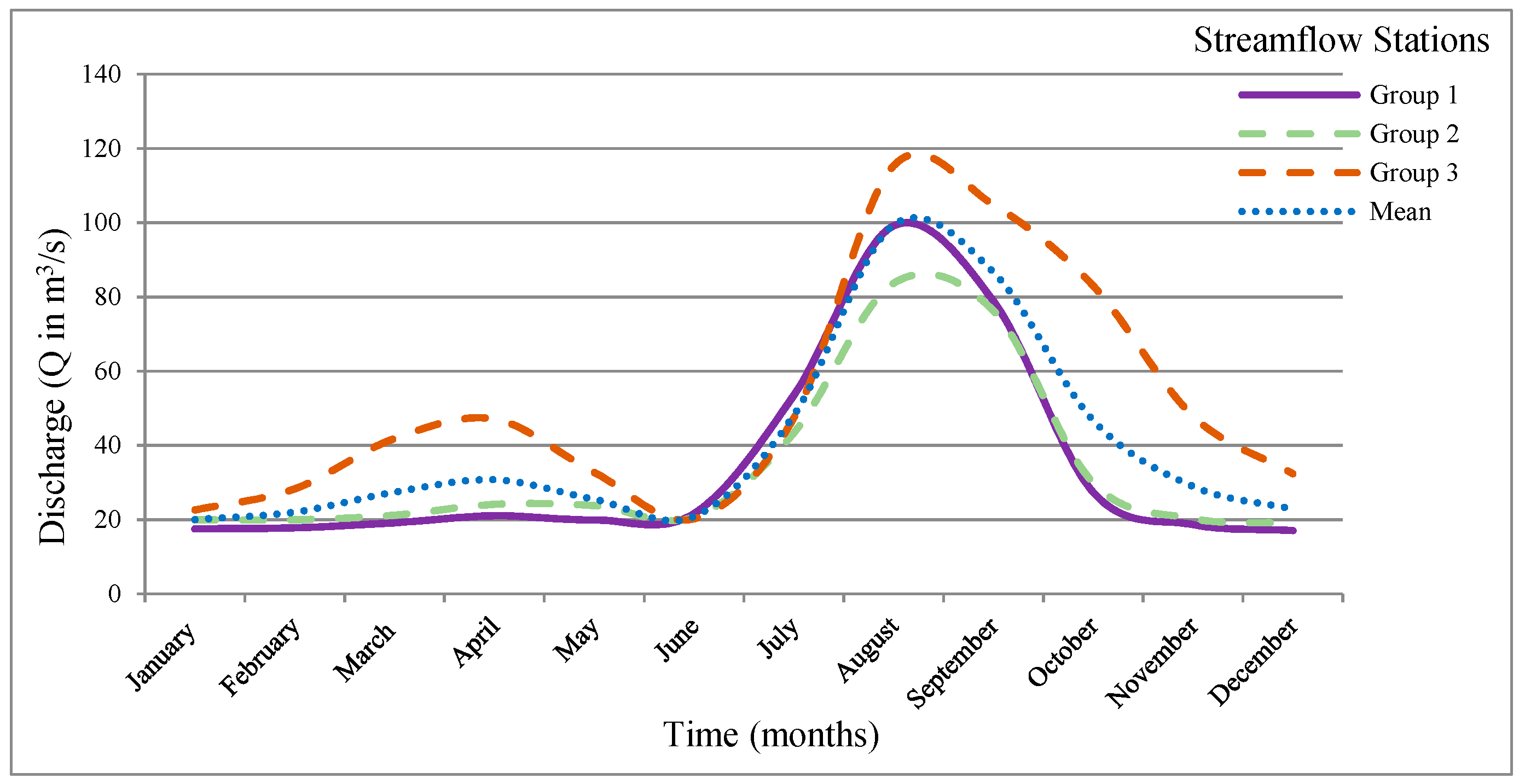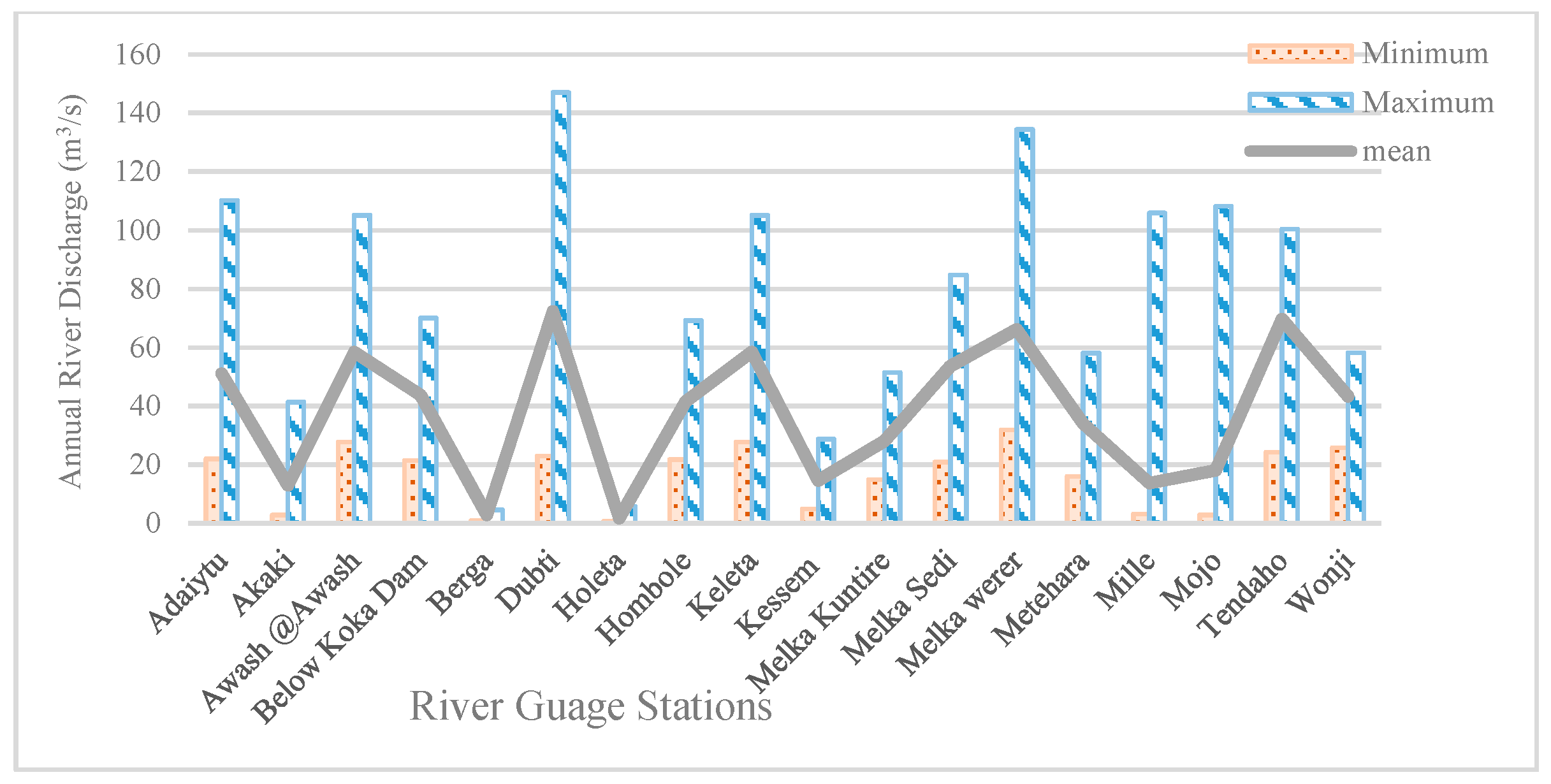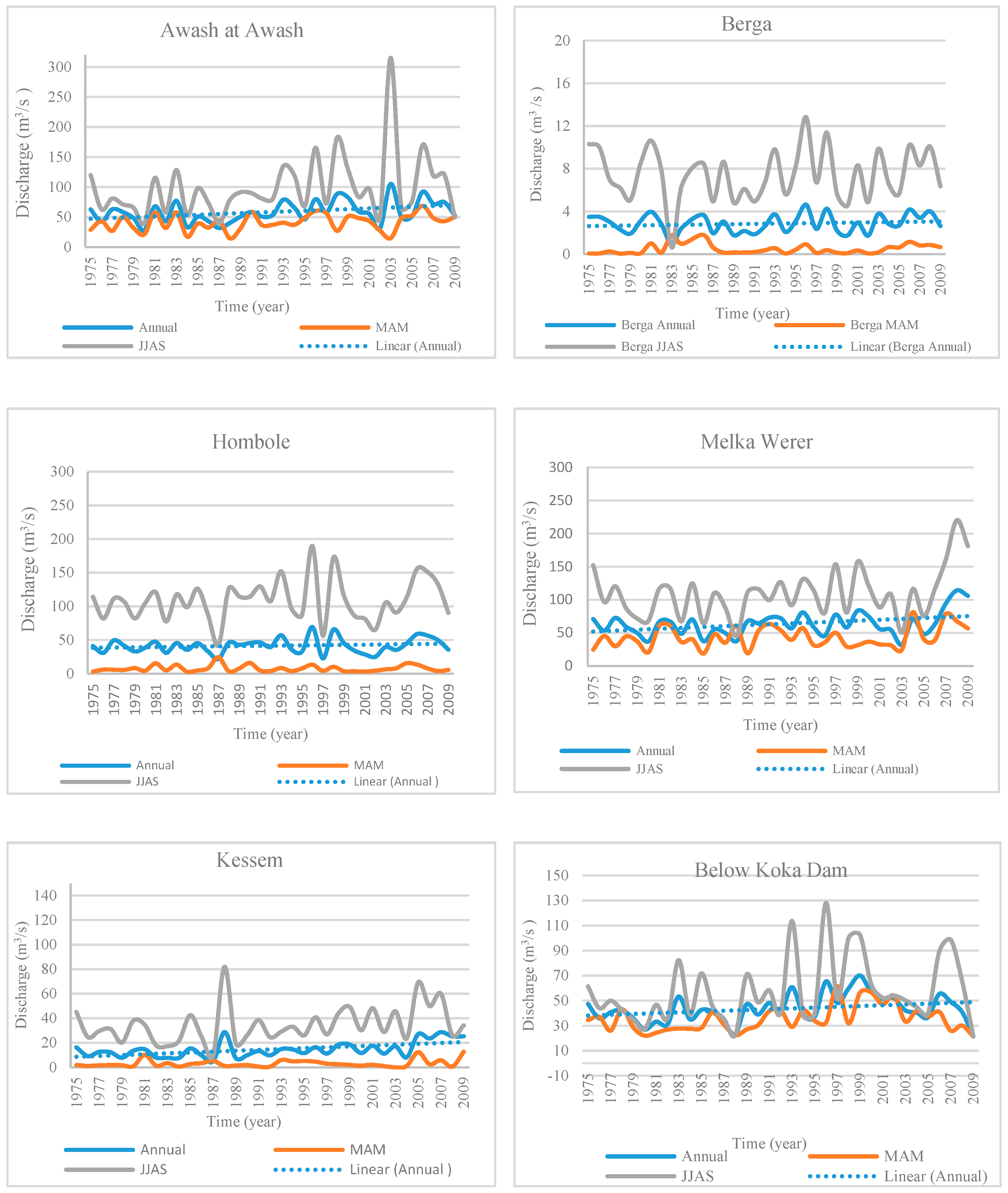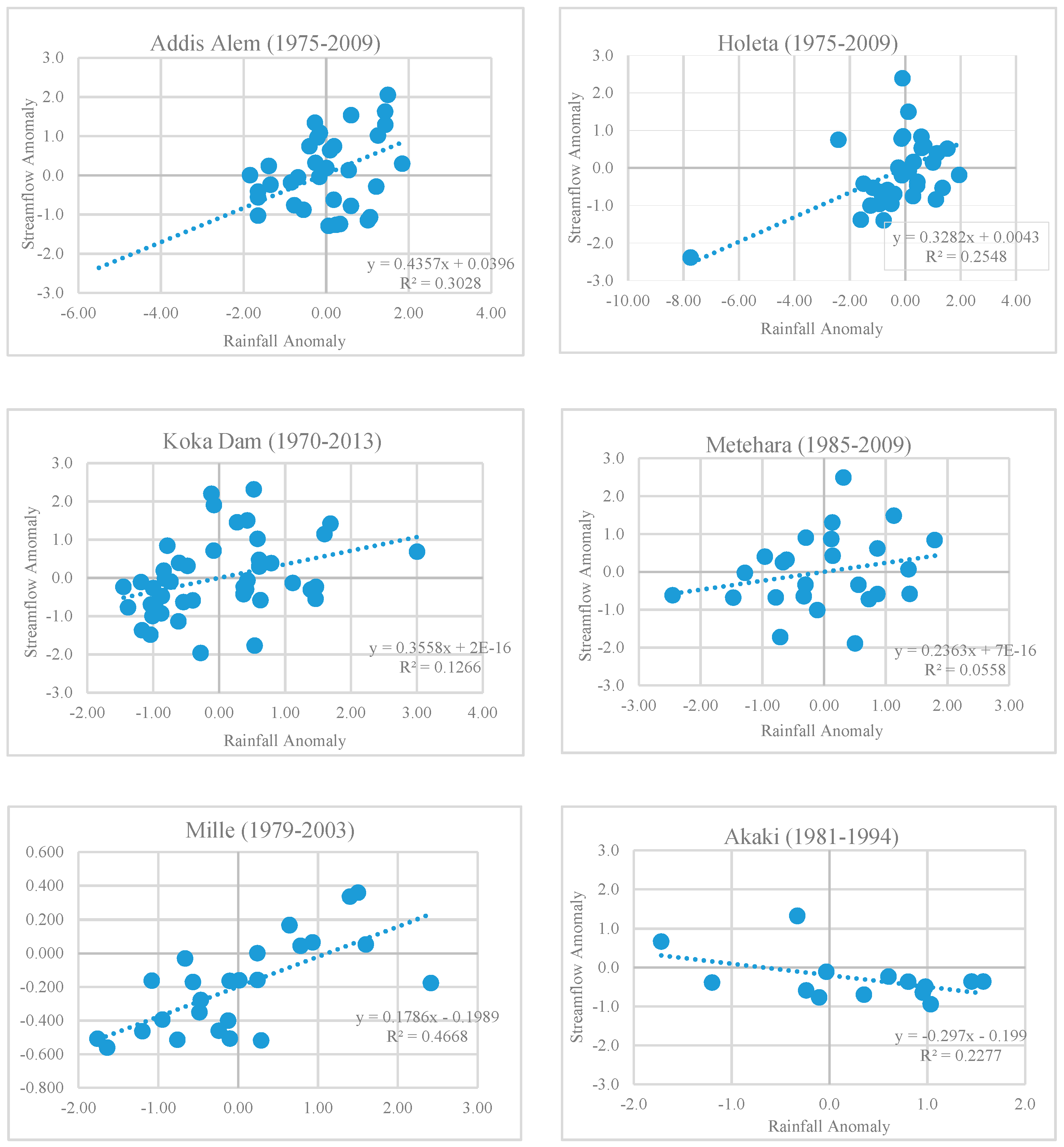1. Introduction
In recent decades, concerns around water resources and climate change have gained global significance. Water resources are exposed to high spatial and temporal hydro-climatic variability, leading to major challenges affecting the economic development [
1]. Climate change and an altered water supply regime have necessitated the need to investigate the relationships between climate and water resources. The availability and accessibility of water resources are mainly reliant on climate and environment of the area. The rainfall variability, alteration in temperature and other climatic variables significantly affect the variation in streamflow level and time of hydrologic events [
2]. The level of streamflow will be affected by several factors which include rainfall characteristics, soil physical properties, watershed factors and human activities [
3].
Water resources in Ethiopia are highly vulnerable to climate and hydrological variability due to its topography and human-induced factors, such as land degradation, high population density and water management practices [
4,
5,
6]. Ethiopia has twelve river basins, out of which the Awash River Basin (ARB) is intensively utilized and environmentally vulnerable. Freshwater biodiversity, basin habitat and human livelihood are exposed to a risk due to over-abstraction of river water, population growth and poor water management [
7]. The Intergovernmental Panel on Climate Change (IPCC) Africa report indicated that in the highlands of Ethiopia, where there is a high and heterogeneous topography, rainfall and floods are expected to increase during the final period of the 21st century [
1].
Previous studies have attempted to characterise rainfall and streamflow in different parts of Ethiopia [
8,
9,
10,
11]. The study by [
12] in the highlands of Ethiopia; [
13] in the Blue Nile; and [
14] in the Rift Valley of Ethiopia, showed an increase in annual temperature and a decline in rainfall trends in growing seasons, but the pattern of annual rainfall indicated no significant and clear trend. Similar studies have been performed in the ARB indicating a non-statistically significant annual rainfall trend with the exception of a negative non-significant trend in a few rainfall stations [
15,
16]. Furthermore, the study by [
17] showed an increasing trend in mean annual rainfall in ARB, and a significantly increasing trend in two stations, while a slightly decreasing trend occurred in the other two stations.
Even though numerous studies related to climate and hydrology in different parts of Ethiopia have been undertaken, little attention has been given to the characteristics and variability of rainfall, temperature and river flow in the ARB. The ARB is the most utilized and developed basin in Ethiopia; however, documentation and data availability are the major problems in this basin [
18]. This might be due to the focus of the Ethiopian Government on the Blue Nile River Basin. All water-based developments in the ARB were established with little knowledge about the river water availability, and without proper water resources management strategy [
16]. Additionally, some studies in the ARB used temperature, rainfall, and land use data which were not sufficient and representative of the whole area. For example, the study by [
19] covered only 7% of the ARB, upstream of Koka Dam because the downstream flow is highly affected by dam and large irrigation lands. Similarly, the study by [
17] analysed only four rainfall and four streamflow stations in ARB, while three of the streamflow stations were located in the Upper Awash Basin. Furthermore, the characteristics of hydro-climatic variables and their trends in the ARB of Ethiopia have not been fully studied and quantified. Therefore, investigating and understanding the characteristics, variability, and the trend of hydro-climatic variables for ARB is important.
The objective of this study was; therefore, to characterize, quantify and validate the variability and trends of hydro-climatic variables in the ARB. The findings of this study will lead to a better understanding of rainfall and water variability in the ARB, including patterns, trends and the extent of the changes. It will also provide guidelines on the appropriate season to implement water saving techniques and help to manage risks from extreme events. In particular, the results of this study will provide valuable information necessary for planning and designing sustainable water management approaches that reduce the impact of droughts and floods in ARB.
4. Discussion
The mean monthly rainfall showed a bimodal pattern with two rainy seasons in the Middle Awash and Lower Awash, while unimodal rainfall was indicated in the Upper Awash. The two rainfall regimes in the Middle and Lower Awash occurred in JJAS and MAM, which presented the main and shorter rainy periods, respectively. Moreover, in all the rainfall stations, the minimum rainfall was recorded in December while the maximum rainfall occurred in August and September. These rainfall regimes coincide with the main agricultural seasons in Ethiopia, whereby agricultural production is predominantly reliant on rainfall. The study by [
16,
24] indicated a similar rainfall pattern; which was unimodal rainfall in Upper Awash and a bimodal rainfall in the Middle Awash and Lower Awash.
The finding of this study indicated the occurrence of temporal variability with an increasing pattern in some stations, and a decreasing pattern in other stations. The JJAS rainfall showed slightly similar result as that of the annual rainfall variability. About 85.7% and 75.3% of the rainfall stations exhibited normal to moderate variability in annual and JJAS rainfall, respectively, whereas, 96.43% of rainfall stations showed a high variability in MAM. The rainfall variability has a direct influence on agricultural water availability and irrigation, especially for countries like Ethiopia, where 85% of the livelihood depends on agriculture. Additionally, the high rainfall variability aggravates the frequency of flood occurrence in this basin. Similarly, the study by [
24] indicated the occurrence of flood and drought due to annual rainfall variability in the ARB. Additionally, the study by [
17] indicated a variability of precipitation and streamflow with 8.49% and 34% coefficients of variation, respectively. The study of [
17] also showed an increasing rainfall trend in Kiremt (JJA) and a decreasing rainfall trend in Meher (September to November), Bega (December to February) and Belg (MAM). The
SAI in annual and seasonal time series indicated a negative anomaly in a closely similar proportion of the observations. Furthermore, the
SAI result showed that most of the years exhibited negative anomaly in MAM rainfall, indicating drier period. Moreover, a lot of large- and small-scale irrigation schemes are found in ARB, especially in the middle Awash, which could be directly affected by low water availability during MAM. The occurrence of high rainfall and streamflow variability combined with the expansion of irrigation in ARB has an influence on agriculture and crop productivity, which aggravates the prevalence of food insecurity and drought in the basin.
The results in most of the streamflow stations revealed that river discharge was low during the months of November to June, but started to increase in July. Furthermore, in all stations, the peak flow occurred in August and September. The monthly river flow was low during the dry period and it started to increase in the rainy season. This meant that the available water supply was limited during the dry season when irrigation is required, and more in the rainy season when hardly any irrigation is needed. Similar to the monthly streamflow, the annual and MAM river discharge indicated a similar pattern except in a few years with extreme high flow records. Moreover, the results showed that the annual temporal variability of streamflow exhibited a positive trend in fourteen stations and a negative trend in four stations.
The Awash River is the major water supply in the ARB that provides regular irrigation water to productive and larger agricultural areas. The high variability during the period MAM and JJAS affects the streamflow level, frequency and the occurrence of extreme hydrological events. As the streamflow variability becomes higher and the water demand increases, water shortage becomes a major threat unless there are adequate water conservation structures and proper water management approaches in this basin. In recent years, there has been significant expansion of irrigation activities in this basin, especially in Upper and Middle Awash region. Furthermore, flood and drought have become major challenges in the ARB [
5,
16]. The MK trend test indicated a significant (0.01 and 0.05) rainfall trend in seven, four and eight stations in annual, MAM and JJAS seasons, respectively. The MK test showed that most of the significant trends in annual rainfall were decreasing except in two stations. Moreover, the negative
Zs and Sen’s slope estimator values were detected in about 71.43%, 64.28% and 53.57% of the stations in annual, MAM and JJAS seasons, respectively, indicating a decreasing rainfall trend. Both the graphical and MK test showed a decreasing trend in most of the rainfall stations, indicating a decline in water availability in ARB.
In addition, the MK test showed a significant (0.01 and 0.05) streamflow trend in five, one and three stations in annual, JJAS and MAM seasons, respectively. Furthermore, a positive Zs and Sen’s slope estimator values were detected in the majority of the stations in annual, MAM and JJAS seasons, indicating an increasing streamflow trend. However, in MAM, a decreasing streamflow trend was detected in Lower Awash at three stations. The streamflow trend in ARB relates to the level of Awash River that contributes to the water availability in this basin. The increasing trend leads to frequent occurrence of peak flows, which aggravates flooding in the area. Furthermore, the results indicated a decreasing streamflow trend in few stations in the Middle Awash and Lower Awash. This low river flow indicated a decline in water availability, which affects the irrigation water supply and also other water use in the ARB, especially in the lower part. The Awash River flow reduction might be related to irrigation expansion in the Upper and Middle Awash, improper water-abstraction, poor water management, climatic factors, population density and environmental change.
The relationship between rainfall and streamflow trends in six stations showed a positive correlation coefficient with relatively good correlation (>0.5) in three stations and poor correlation (<0.4) in two stations. The correlation observed at the two stations, below Koka dam and Mille, might be affected due to the monitoring effect of Koka and Tendaho reservoirs, respectively. Moreover, the rainfall–streamflow trends showed that rainfall was not the only factor that influenced the variability and availability of streamflow in this basin. Further research is recommended to investigate other factors that influence variability in Awash River flow and the rainfall–streamflow relationships, for instance: the density of physical properties, watershed characteristics and environmental factors like vegetation cover.
5. Conclusions
The objective of this study was to characterise, quantify and validate the variability and trends of hydro-climatic variables in the ARB in Ethiopia using graphical and statistical methods. The rainfall and streamflow trends and their relationships were analysed using regression method, MK test and correlation analysis. The main findings of this research are summarised as follows:
A bimodal pattern with two rainy seasons was displayed in the mean monthly rainfall in the Middle and Lower Awash, while the pattern in the Upper Awash was unimodal. In the majority of the stations, the rainfall exhibited from normal to moderate variability in the mean annual and the JJAS period, whereas it was highly variable in almost all stations during the MAM rainfall season.
High streamflow variability was observed in MAM and JJAS periods. Besides, the monthly river flow was low during the dry season of the year, but started to increase in the rainy season. Shortage of rainfall in MAM and low monthly streamflow during the dry period leads to a decline in water supply in ARB.
The MK trend test showed that most of the significant trends in annual rainfall were decreasing. The negative Zs and Sen’s slope estimator values were detected in about 71.43%, 64.28% and 53.57% of the stations in annual, MAM and JJAS seasons respectively, indicating a decreasing rainfall trend. Both the graphic and MK test indicated a decreasing trend in most of the stations, which may result in a decrease in water availability in ARB.
The MK trend test revealed an increasing annual streamflow trend in 27.8% of the stations, whereas, in the MAM period, a decreasing trend was displayed in the Lower Awash at three stations. Moreover, a positive Zs and Sen’s slope estimator values were observed in majority of the stations in annual, MAM and JJAS seasons, indicating an increasing streamflow trend. An increasing trend was shown in most of stations in Upper and Middle Awash, whereas a decreasing trend was revealed in Lower Awash.
The trend relationship between rainfall and streamflow in six stations indicated a positive correlation coefficient, with slightly good correlation in four stations and poor correlation in two stations. The correlation observed downstream of Koka and Tendaho dams might be affected due to the monitoring effect of Koka and Tendaho reservoirs, respectively. Moreover, the rainfall–streamflow trend relationship showed that rainfall was not the only factor that influenced the variability and availability of streamflow in this basin. The other factors that influence variability in Awash River flow and the rainfall–streamflow relationship includes physical property, watershed characteristics and environmental factors, like vegetation cover, which still needs further assessment.
The findings of this study provide valuable information on the characteristics and variability of rainfall and streamflow necessary for planning and designing of sustainable water management strategies and minimizing the impact of droughts and floods in the ARB. The cause of an increasing trend in streamflow might be urbanisation, land degradation, population density and climatic factors. However, the declining trend might be related to irrigation expansion in Upper and Middle Awash, improper water-abstraction and poor water management, climatic factors and environmental changes in the basin. Therefore, further assessment on factors influencing the variability and availability of Awash River flow is needed in order to implement a sustainable water management strategy and also to mitigate the adverse effects of water scarcity and extreme events on the food security, livelihoods, environment and overall development of the country. Additionally, further research on river water management and water saving techniques is recommended to cope with the high variability of river flow and rainfall in this basin.
